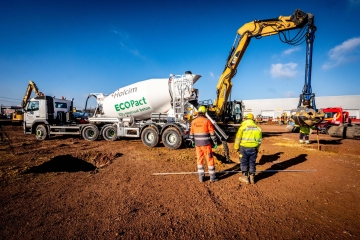Building according to the 2050 goals

A major challenge for our future buildings is to reduce the environmental impact, as our current method of construction leads to too great an environmental impact to stay within the carrying capacity of the earth with our building needs.
A major challenge for our future buildings is to reduce the environmental impact, as our current method of construction leads to too great an environmental impact to stay within the carrying capacity of the earth with our building needs.
Research shows that in new buildings (low energy buildings) the materials are responsible for almost as much greenhouse gas as the use phase. Life Cycle Assessment (LCA) is a tool that allows the environmental impact of a building to be mapped over its entire life cycle. It not only considers the impact on climate change, but a whole range of environmental indicators are taken into account, such as particulate matter formation, resource depletion, biodiversity loss and toxicity, among others.
Since February 2019, a free online tool is available, TOTEM, which allows to calculate the life cycle impact of buildings and thus adjust the design. The tool provides insight into which elements contribute most to the impact, during which life cycle phases the greatest impact is caused and on which environmental indicators the design scores worst. This allows architects to make targeted design adjustments and make informed choices regarding building design, choice of materials and energy performance.
In order to reduce the material impact, architects can use various strategies. Three principles underlie these strategies:
- reduce material consumption,
- filling the remaining demand with materials with a low environmental impact and
- maximizing the life span of the materials.
In order to extend the life span, a great deal of attention has recently been paid to circular construction, in which people look for ways to reuse or recycle materials to a high standard at the end of the building's life. But equally, people are looking for building designs that allow for flexibility and adaptability in order to accommodate new needs or new programs. Buildings of the future will thus have a lower impact on the environment, and may even be built from raw materials that are already present in our buildings. Buildings will then become banks of materials.
The role of concrete in reducing the environmental impact of construction
At the request of FEBELCEM, Professor Karen Allacker of KU Leuven, applied the TOTEM tool on the one hand to a row house (2018) and on the other hand to an apartment building (2020).
In the case of the row house, three construction techniques were compared: brick, concrete and timber frame. The difference in environmental cost between the three variants is insignificant (less than 5%). Also for the apartment building, three construction variants were compared: steel, concrete and CLT ('cross laminated timber'). Here, however, large differences in environmental cost per m² of gross floor area were identified. The steel variant clearly stands out with a high environmental cost. Concrete and CLT come out on roughly the same level (overall a difference of less than 5% and thus negligible), with a favorable score for concrete as far as the production phase is concerned.
Holcim's efforts towards a CO2-neutral concrete
Within this target, construction producers are also investing heavily in product innovation to reduce the climate change and other environmental impacts of their materials.
In addition to the sustainable aspects of concrete demonstrated by the above-mentioned research, Holcim Belgium is also looking for other ways to reduce its environmental impact. This includes replacing part of the energy-hungry clinker in cement by secondary raw materials originating from power stations, blast furnaces or the chemical industry and by upgrading residual products from industry to alternative fuels for the heating process of clinker production. But also by working on concepts to neutralize the CO2 emissions of concrete.
This is the philosophy behind Holcim's ECOPact concrete: the CO2 balance of the concrete is reduced as much as possible by applying five strict requirements on production and delivery:
- The use of raw materials with a low ecological footprint;
- CO2-neutral or CSC (Concrete Sustainability Council) labeled production sites;
- Transportation of concrete with Euro 6 vehicles;
- An analysis of the carbon content, which is carried out and validated by an external organization at the end of each project;
- The share of incompressible CO2 emissions is offset by investing in certified sustainable local and international development projects in partnership with CO2logic and the Royal Belgian Forestry Commission.
For example, the ECOPact concrete is used to raise the new innovation campus of Living Tomorrow.
Cooling concrete as a serious future development
Another example is a new type of concrete being developed by an extensive consortium of research centers (including KU Leuven) with European support within the H2020 project MIRACLE. This project aims to develop a photonic meta concrete that emits more heat than it absorbs, resulting in a net cooling effect. More specifically, the MIRACLE concrete will emit a lot of radiation with a wavelength between 8 and 13 micrometers because radiation with this wavelength is hardly stopped by the atmosphere and is therefore sent out into the universe. In this way, buildings are cooled and concrete can contribute to avoiding further global warming. These properties are intended to be obtained by combining an ordered pattern of microfibers in steel with a hierarchical porous structure of the concrete.
Concrete will thus continue to make an important contribution in the buildings of the future.
Latest insights & stories

A Global Movement: The World Unites in a Pink Pledge for Clean and Sustainable Water
5,000 participants. 32 countries. €30,000 funds raised. And that's just the beginning.
Picture this: One step that sends ripples across the globe, transforming lives and creating waves of change. You might wonder, how can such a simple action for most of us have such a profound impact?

Sustainability and circularity in construction
Join us in transforming the future of construction, creating buildings that not only stand the test of time but also contribute to a healthier planet!

RainTunes: Shower scenarios for the soul
Light, hearing, smell, and touch: Together with experts, we have developed sensuous scenarios that turn showering into an individual experience. Whether you want to prepare for the day ahead or relax after working out. Whether you want to refresh after a day’s work or unwind at the end of the evening: RainTunes surprises with multisensory experiences.*
*Currently available only in Germany and Austria.